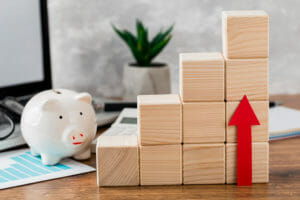
How To Build an Emergency Fund?
An emergency fund is a sum of cash saved to help you through a financial downfall. For example, a job loss, an unexpected bill, or a sudden budgeting error. Giving yourself a sum of money and saving enough to fall back on will help you avoid having to borrow payday loans or face difficult financial choices. The goal of an emergency fund is to provide financial stability by offering a safety net that may be used to cover unforeseen costs. After all, we never know what’s around the corner. For many of us, the worst financial scenarios always seem to occur at the worst moments. Even though payday loans are useful, we advise borrowers to seek help from their personal savings before applying. This way, your risk of falling further into the cycle of debt is greatly reduced. So, here are some tips on how to build an emergency fund…
What Is the Appropriate Amount for an Emergency Fund?
Experts suggest that you should always have three to six months’ worth of expenses saved and put away. This guarantees that you will always have a substantial amount of money available at all times in case of unforeseen expenses. However, having less money saved is much better than having no money saved at all. In fact, a very small percentage of the population will have six months’ worth of expenses saved. Studies suggest that 51%, of Americans, have less than three months’ worth of emergency savings. So, if you’re struggling to reach that amount, or perhaps it’s taking longer than expected, don’t worry.
Maintaining a separate emergency fund from your usual savings is indeed beneficial. By doing this, you can prevent yourself from being tempted to use your emergency fund to pay for something you had been saving for, like a new phone, or perhaps the vacation you’ve been dreaming of.
How Do I Build One?
Building an emergency fund takes plenty of time and effort. However, it’s something that must be done in order to protect us in the future. If you find yourself in any financial difficulties whilst your emergency fund is low, we can help. Learn more here!
Specify a monthly savings target:
It is important to focus on smaller, more manageable monthly objectives rather than one huge savings target. Gaining momentum through consistency and being inspired to continue saving will come from achieving monthly milestones. This can help make the process of creating your emergency fund less intimidating overall and help you maintain the practice of saving frequently.
Automatically deposit funds into your savings account:
If you begin feeling as though money might be tighter than usual at some point, it is likely you’ll reduce the amount you’re willing to save, or maybe skip the month. However, establishing a routine with this can completely derail your chances of increasing the balance. Therefore, instead of manually depositing the finances into the account, why not try it automatically? Setting up a direct debit is easier than ever; you can now even do this online.
Keep saving after hitting your goal:
With the cost of living rising, it’s critical to continue saving even after your goals have been met. The more you put into your emergency fund, the longer you’ll be capable of surviving without an income if you find yourself without a financial stream. Not only this, but the more you’re able to save, the better covered you’ll be.
